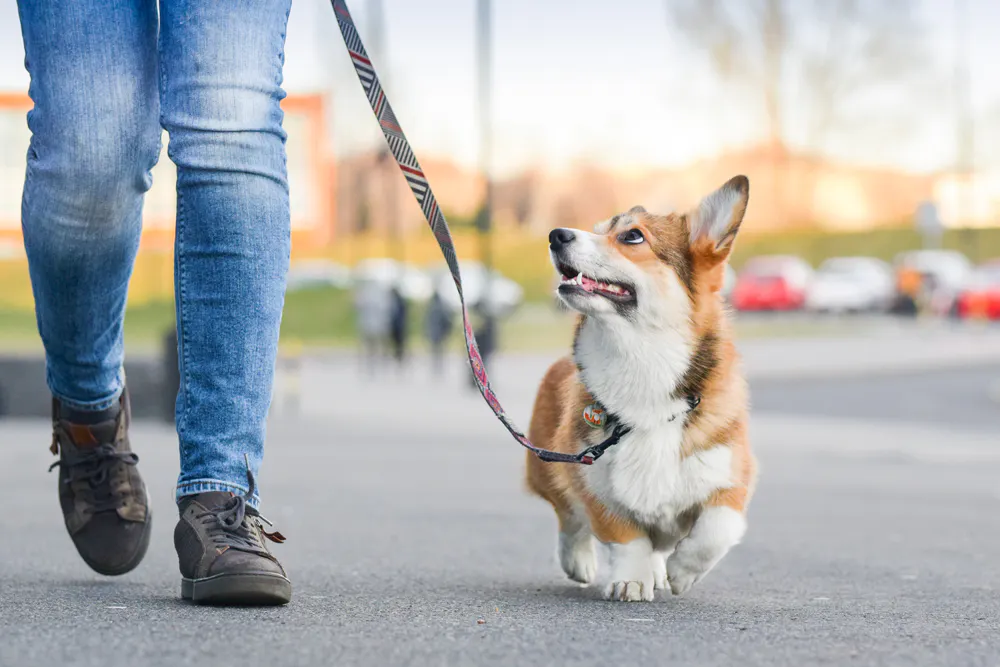Loose leash walking teaches your dog to walk beside you without pulling, promoting a more enjoyable and controlled walking experience for both of you.
Unleash the Potential of Your Dog’s Walks with These Loose Leash Walking Techniques
Loose leash walking is an essential skill that all dog owners should teach their dogs. It not only makes walks more enjoyable for both the dog and the owner, but it also promotes better communication, provides exercise, and strengthens the bond between dog and owner.
Teaching a dog to walk on a loose leash can be challenging, but with patience, consistency, and positive reinforcement, it can be achieved.
The Importance of Loose Leash Walking
Loose leash walking is important for both the dog and the owner. For the dog, it allows them to explore their surroundings while still being under control. It also provides mental stimulation and exercise, which are crucial for a dog’s overall well-being. For the owner, loose leash walking makes walks more enjoyable and less stressful. It allows them to have better control over their dog and reduces the risk of accidents or injuries.
In addition to these benefits, loose leash walking also strengthens the bond between dog and owner. When a dog learns to walk calmly by their owner’s side, it shows trust and respect. It also improves communication between the two, as the owner can give clear cues and the dog can respond appropriately. Overall, loose leash walking is an important skill that enhances the quality of life for both dogs and their owners.
Understanding Your Dog’s Walking Habits
Before teaching your dog to walk on a loose leash, it’s important to understand their walking habits. Dogs may exhibit different behaviors while on a walk, such as pulling, zigzagging, or stopping frequently. By understanding these habits, you can tailor your training approach to address them effectively.
For example, if your dog tends to pull on the leash, you can focus on teaching them to walk calmly by your side using positive reinforcement techniques. If your dog tends to zigzag or stop frequently, you can work on teaching them to stay focused and engaged during walks.
Understanding your dog’s walking habits also helps you identify any underlying issues that may be causing the behavior. For instance, if your dog pulls on the leash because they are anxious or excited, you can address these issues separately to help them become more comfortable and calm during walks.
Using Positive Reinforcement to Encourage Loose Leash Walking
Positive reinforcement training is a highly effective method for teaching dogs to walk on a loose leash. It involves rewarding desired behaviors with treats, praise, or other rewards, which encourages the dog to repeat those behaviors in the future.
When it comes to loose leash walking, positive reinforcement can be used to reward your dog for walking calmly by your side. For example, every time your dog walks without pulling on the leash, you can give them a treat or praise. This positive association helps them understand that walking on a loose leash is a desirable behavior.
It’s important to use rewards that are highly motivating for your dog. This could be their favorite treats, toys, or even verbal praise. The key is to make the reward something that your dog finds valuable and will work for.
Implementing the “Stop and Go” Method
The “stop and go” method is a popular technique for teaching dogs to walk on a loose leash. It involves stopping whenever your dog pulls on the leash and only moving forward when they return to a loose leash position.
To implement this method, start by walking with your dog on a loose leash. As soon as they start pulling, stop in your tracks and wait for them to return to your side. Once they do, reward them with a treat or praise and continue walking. Repeat this process every time your dog pulls on the leash.
Over time, your dog will learn that pulling on the leash does not get them where they want to go. Instead, they will understand that walking calmly by your side is what leads to forward movement and rewards.
Teaching Your Dog to Check-In with You
Teaching your dog to check-in with you while walking is an important aspect of loose leash walking. It helps keep them engaged and focused on you, rather than being distracted by their surroundings.
To teach your dog to check-in, start by using a verbal cue, such as “check-in” or “look.” Whenever your dog looks at you during a walk, reward them with a treat or praise. Gradually increase the duration of eye contact before giving the reward.
You can also use a treat as a lure to get your dog’s attention. Hold a treat near your face and say the verbal cue. When your dog looks at you, reward them with the treat. With practice, your dog will learn to check-in with you regularly during walks.
Using Treats to Encourage Good Behavior
Using treats to encourage good behavior while walking is an effective way to reinforce loose leash walking. Treats can be used as rewards for walking calmly by your side, checking in with you, or responding to cues.
When using treats, it’s important to use high-value rewards that your dog finds particularly enticing. This could be small pieces of cooked chicken, cheese, or freeze-dried liver treats. The key is to make the treats more rewarding than any distractions or urges your dog may have while walking.
It’s also important to reward good behavior immediately. This helps your dog make the connection between their behavior and the reward. Carry treats with you on walks and be ready to reward your dog as soon as they exhibit the desired behavior.
The Benefits of Using a Front-Clip Harness
Using a front-clip harness can be beneficial for loose leash walking. Unlike traditional harnesses or collars that attach at the back, front-clip harnesses have the attachment point on the chest. This helps discourage pulling by redirecting the dog’s forward momentum towards the side.
A front-clip harness also provides better control and communication between dog and owner. When the leash is attached to the front of the harness, it allows the owner to guide the dog’s movements more effectively. This can be particularly helpful when teaching a dog to walk on a loose leash.
Additionally, a front-clip harness can help prevent injuries that may occur from pulling on a traditional collar or back-clip harness. It distributes the pressure more evenly across the dog’s body, reducing the risk of strain or discomfort.
Avoiding Common Mistakes in Loose Leash Walking
When teaching your dog to walk on a loose leash, it’s important to avoid common mistakes that can hinder their progress. One common mistake is being inconsistent with your training. Dogs thrive on consistency, so it’s important to use the same techniques and cues every time you go for a walk.
Another mistake is not being patient enough. Loose leash walking takes time and practice, so it’s important to be patient with your dog as they learn. Rushing the process or becoming frustrated can make it more difficult for your dog to understand what is expected of them.
It’s also important to avoid using punishment or negative reinforcement when teaching loose leash walking. This can create fear or anxiety in your dog and make them less likely to engage in the desired behavior. Stick to positive reinforcement techniques and reward your dog for their efforts.
Dealing with Distractions on Walks
Distractions are inevitable during walks, whether it’s other dogs, people, or interesting smells. It’s important to know how to deal with these distractions in order to keep your dog focused and engaged.
One way to deal with distractions is by using a cue or command that redirects your dog’s attention back to you. For example, you can use a “watch me” command or a hand signal that signals your dog to look at you instead of the distraction. Reward your dog for responding to the cue and redirecting their attention.
Another strategy is to create distance between your dog and the distraction. This can be done by crossing the street, changing direction, or moving to the side. By creating distance, you can help your dog stay focused on you and reduce the intensity of the distraction.
It’s also important to be patient and understanding when your dog gets distracted. Remember that dogs are naturally curious and may need time to investigate their surroundings. Use treats or praise to reward your dog for refocusing on you after a distraction.
Keeping Your Dog Engaged and Focused
Keeping your dog engaged and focused during walks is crucial for loose leash walking success. There are several strategies you can use to achieve this.
One strategy is to vary your walking route. Dogs thrive on novelty, so changing up the scenery can help keep them engaged and interested. Explore different neighborhoods, parks, or trails to provide new sights, sounds, and smells for your dog to experience.
You can also incorporate interactive toys or games into your walks. For example, you can bring a ball or a frisbee and play fetch during breaks. This not only provides mental stimulation but also helps burn off excess energy.
Training exercises can also help keep your dog engaged and focused. Incorporate short training sessions during walks to work on basic obedience commands or tricks. This helps keep their mind active and reinforces their training.
Consistency is Key in Achieving Loose Leash Walking Success
Consistency is key when it comes to teaching your dog to walk on a loose leash. Dogs thrive on routine and repetition, so it’s important to practice regularly and use the same techniques every time.
Set aside dedicated time each day for loose leash walking practice. Start with short sessions and gradually increase the duration as your dog becomes more comfortable and proficient. Consistency in training helps reinforce the desired behavior and makes it easier for your dog to understand what is expected of them.
Consistency also extends to your own behavior and cues. Use the same verbal cues, hand signals, and rewards every time you go for a walk. This helps your dog make the connection between their behavior and the desired outcome.
Teaching your dog to walk on a loose leash is an important skill that enhances the quality of life for both dogs and their owners. It promotes better communication, provides exercise, and strengthens the bond between dog and owner. By understanding your dog’s walking habits, using positive reinforcement techniques, and being consistent in your training, you can achieve loose leash walking success. Remember to be patient, stay consistent, and enjoy the journey of teaching your dog this valuable skill.
Johny is a dedicated pet enthusiast, author, and the driving force behind the insightful content at PetSWAT. With a deep passion for animals and a wealth of knowledge acquired through years of experience, Johny brings a unique perspective to the world of pet care and companionship.



